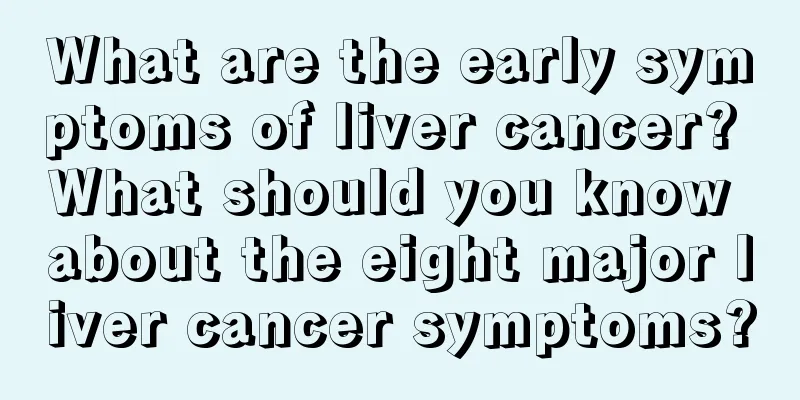What are the early symptoms of liver cancer? What should you know about the eight major liver cancer symptoms?

|
What is liver cancer? How do we identify liver cancer? What are its specific symptoms? We must carefully analyze these questions, because there are many things that are not as simple as just looking at the surface. So, what are the symptoms of early liver cancer? What are the symptoms of late liver cancer? Symptoms of liver cancer: loss of appetite, fatigue, poor appetite, weight loss, liver pain, jaundice, ascites, liver pain, etc. are the most characteristic clinical symptoms of liver cancer. The early symptoms of liver cancer include: ⒈ Jaundice, ascites, and skin itching; ⒉ Often manifested as nose bleeding, subcutaneous bleeding, etc. ⒊ Fatigue, weight loss, unexplained fever and edema; ⒋ Significant loss of appetite: abdominal distension, indigestion, sometimes nausea and vomiting; 5. Dull pain in the right upper abdomen: There may be persistent or intermittent pain in the liver area, which may sometimes be aggravated by changes in body position; The symptoms of advanced liver cancer include: ⒈ Gastrointestinal symptoms: decreased appetite, indigestion, nausea, vomiting and diarrhea are easily overlooked due to their lack of sex specificity. ⒉ Fatigue, weight loss, general weakness. A small number of patients may develop cachexia in the late stage. ⒊ Fever: Generally, the temperature is low and reaches above 39℃, which is continuous fever or low fever in the afternoon or high fever of remittent type. Fever is related to the absorption of necrotic products of tumor. Compression or invasion of bile duct by tumor may cause biliary infection. ⒋ Pain in the liver area: The most common type is intermittent and persistent dull pain or bloating. The pain is caused by the rapid growth of the cancer, which tightens the liver capsule and causes the tumor to invade the diaphragm. The pain may radiate to the right shoulder or right back. The tumor growing to the right back may cause right waist pain. The sudden onset of severe abdominal pain and peritoneal irritation signs indicates bleeding under the capsule of the cancer nodule or rupture into the abdominal cavity. 5. Symptoms of metastatic lesions: There are corresponding symptoms at the place where the tumor metastasizes, which sometimes become the first symptoms of liver cancer. For example, metastasis to the lungs can cause coughing and hemoptysis; pleural metastasis can cause chest pain and bloody pleural effusion; embolism of the pulmonary artery or branches can cause pulmonary infarction, which can cause sudden severe dyspnea and chest pain; blocking the inferior vena cava with cancer thrombus can cause severe edema of the lower limbs and even a drop in blood pressure; blocking the hepatic vein can cause Budd-Chiari syndrome and edema of the lower limbs; metastasis to the bones can cause local pain or pathological fractures; metastasis to the spine or compression of the spinal nerves can cause local pain and paraplegia; intracranial metastasis can cause corresponding localization symptoms and signs, such as intracranial hypertension, which can lead to brain herniation and sudden death. 6. Paraneoplastic syndrome: The abnormal metabolism of the tumor itself affects the body and causes endocrine or metabolic abnormalities, which is called paraneoplastic syndrome. Hypoglycemia and polycythemia are the most common, while other rare syndromes include hyperlipidemia, hypercalcemia, precocious puberty, gonadotropin secretion syndrome, carcinoid syndrome, etc. ⒎Sign of liver cancer - jaundice. Jaundice is a common sign of mid- to late-stage liver cancer. Diffuse liver cancer and cholangiocarcinoma are most likely to cause jaundice. Jaundice is mostly caused by compression of the bile duct or invasion of the bile duct by cancer, or by compression of the bile duct by enlarged lymph nodes metastasized from the liver hilum. In a few cases, the liver cancer tissue grows into the bile duct, and the mass blocks the bile duct, causing obstructive jaundice. ⒏ Other systemic symptoms: Endocrine or metabolic syndromes caused by abnormal metabolism of the tumor itself or the various effects of cancer tissue on the body are called paraneoplastic syndromes, which sometimes occur before the symptoms of liver cancer itself. |
<<: What to eat in the late stage of lung cancer? Analysis of diet plan for lung cancer patients
Recommend
Does washing hair during menstruation increase the incidence of cervical cancer? What should you pay attention to in order to prevent cervical cancer?
For a long time, there have been rumors online th...
What to do if pancreatic cancer recurs
When it comes to pancreatic cancer, many people a...
Early symptoms and manifestations of colorectal cancer
Early symptoms of colorectal cancer include abdom...
How to treat weakness and easy sweating
Today's life and work have brought us a lot o...
My legs are weak and I always feel tired
Some people feel like their legs weigh thousands ...
How often should I have a checkup after chemotherapy for gastric cancer
How often should I be examined after chemotherapy...
What can be used to increase the cuticle
A thin stratum corneum is often due to poor skin ...
What to do if your eyelids swell up after using makeup
Many people wear makeup regularly, but if they ch...
Which 125-particle intervention for thyroid cancer bone metastasis is more effective? What is 125-particle intervention for thyroid cancer bone metastasis?
Thyroid cancer is a disease that is relatively di...
What harm does colon cancer bring to the body
Everyone knows that colon cancer is a serious can...
My right cheek hurts when I open my mouth wide_My right cheek hurts when I open my mouth wide_My right cheek hurts when I open my mouth wide
Symptoms of cheek pain after opening your mouth a...
The efficacy and function of camphor oil
In nature, many trees also have magical effects a...
Breast cancer immunohistochemistry
Breast cancer immunohistochemistry is an importan...
Patients with cardia cancer should pay attention to dietary care methods
Patients with cardia cancer need to pay attention...
How is manic depression treated?
As the pace of modern people's lives accelera...









